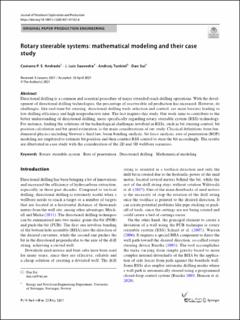| dc.contributor.author | Andrade, Caetano | |
| dc.contributor.author | Saavedra, Luis | |
| dc.contributor.author | Tunkiel, Andrzej Tadeusz | |
| dc.contributor.author | Sui, Dan | |
| dc.date.accessioned | 2021-08-15T19:03:58Z | |
| dc.date.available | 2021-08-15T19:03:58Z | |
| dc.date.created | 2021-05-26T09:20:29Z | |
| dc.date.issued | 2021-05 | |
| dc.identifier.citation | Andrade, C.P.S., Saavedra, J.L., Tunkiel, A., Sui, D. (2021) Rotary steerable systems: mathematical modeling and their case study. Journal of Petroleum Exploration and Production, 11, pp. 2743–2761 | en_US |
| dc.identifier.issn | 1091-6466 | |
| dc.identifier.uri | https://hdl.handle.net/11250/2767849 | |
| dc.description.abstract | Directional drilling is a common and essential procedure of major extended reach drilling operations. With the development of directional drilling technologies, the percentage of recoverable oil production has increased. However, its challenges, like real-time bit steering, directional drilling tools selection and control, are main barriers leading to low drilling efficiency and high nonproductive time. The fact inspires this study. Our work aims to contribute to the better understanding of directional drilling, more specifically regarding rotary steerable system (RSS) technology. For instance, finding the solutions of the technological challenges involved in RSSs, such as bit steering control, bit position calculation and bit speed estimation, is the main considerations of our study. Classical definitions from fundamental physics including Newton’s third law, beam bending analysis, bit force analysis, rate of penetration (ROP) modeling are employed to estimate bit position and then conduct RSS control to steer the bit accordingly. The results are illustrated in case study with the consideration of the 2D and 3D wellbore scenarios. | en_US |
| dc.language.iso | eng | en_US |
| dc.publisher | Springer Nature Switzerland AG | en_US |
| dc.rights | Navngivelse 4.0 Internasjonal | * |
| dc.rights.uri | http://creativecommons.org/licenses/by/4.0/deed.no | * |
| dc.subject | petroleumsteknologi | en_US |
| dc.subject | rotary steerable system | en_US |
| dc.subject | mathematical modeling | en_US |
| dc.title | Rotary steerable systems: mathematical modeling and their case study | en_US |
| dc.type | Peer reviewed | en_US |
| dc.type | Journal article | en_US |
| dc.description.version | publishedVersion | en_US |
| dc.rights.holder | © The Author(s) 2021 | en_US |
| dc.subject.nsi | VDP::Teknologi: 500::Berg‑ og petroleumsfag: 510::Petroleumsteknologi: 512 | en_US |
| dc.source.pagenumber | 2743–2761 | en_US |
| dc.source.volume | 11 | en_US |
| dc.source.journal | Petroleum science and technology | en_US |
| dc.identifier.doi | 10.1007/s13202-021-01182-6 | |
| dc.identifier.cristin | 1911853 | |
| cristin.ispublished | true | |
| cristin.fulltext | original | |
| cristin.qualitycode | 1 | |

